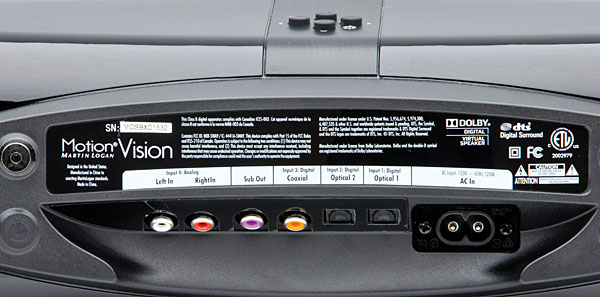MartinLogan Motion Vision Soundbar

My system is perpetually a work in progress. The speaker stands are always serving new guests (with martinis). Surround receivers slide in and out of the rack’s guest-receiver berth to bedevil me with the GUI of the week. But once in a while, I can’t resist the temptation to yank every cable out of every back panel, throw them onto the middle of the floor, and marvel as the mountain of copper snakes gets higher and higher. Last year, my system spring cleaning yielded a record haul: More than half the cables I pulled out didn’t go back in.
That process of cleansing, of simplification, of whittling things down to essentials is one of the gratifying side effects of reviewing a powered soundbar. For a little while, I get to see how the saner half lives. I can even visualize it, gazing at my system, watching the relevant components glow while the others remain dark. I see the soundbar itself, of course, and my smallish flat-panel HDTV, universal disc player, and cable box. And nothing else. All of it can be confined to the walnut double-decker TV table. The result may not sound as awe-inspiring as my rack full of reference components at full tilt. But it’s a great blueprint for a no-fuss system that might fit into a bedroom, summer cabin, or space-starved studio apartment.

And the better it sounds, the less I miss my reference system. So I was full of good spirits (not necessarily martinis) when I unpacked the MartinLogan Motion Vision soundbar, laid it on the double-decker in front of the TV, and installed the disc player and cable box on the shelf below. Though I couldn’t see beneath the nondetachable grille, I knew this soundbar was packing a trio of Folded Motion transducers—pleated panel tweeters, in the vulgate—and I was eager to see how much, or little, I might miss my reference system over the days to come.
The Big Squeeze
While MartinLogan is best known for its tall and elegant electrostatic speakers, its adeptness with flat diaphragms carries over to a line of box speakers with Folded Motion tweeters, a trademarked term, though similar drivers have been turning up lately in other manufacturers’ speakers. We reviewed the Motion 40 towers as a stereo pair in the October 2012 issue; a full theater system review is on the way. This Motion line now sports a sound-bar, the Motion Vision.
Any speaker driver works by modulating air pressure in the room, but the motion it uses can vary. MartinLogan’s pleated tweeter—made of polyimide film with aluminum conductive traces, the opening of which measures about 1 by 1.5 inches—doesn’t pump piston-like as a driver with a dome or cone does. It squeezes air more like an accordion. The result here is said to be an 80 x 80-degree dispersion pattern that is equal in both the horizontal and vertical planes, and a scrupulous approach to timbre that is most un-soundbar-like. In fact, it makes most other soundbars seem crude by comparison.
The three Folded Motion tweeters mate with a quartet of 4-inch paper-coned woofers and two rear-firing ports in a heavy gloss black plastic enclosure nearly 40 inches in width. These seven drivers form a virtual 5.1channel system with the aid of some slick digital signal processing and onboard decoding for Dolby Digital 5.1 and DTS 5.1. Also included is Dolby Virtual Speaker technology, which is designed to produce surround-like effects from a smaller speaker array, as little as a single pair.
Power resources are modest: 16.5 watts times four for the woofers, 13.7 watts times three for the tweeters. These are the company’s internal measurements; they’re not on the spec sheet. The total is 107 watts, and the spec sheet claims peak power output of 200 watts. The system is rated down to 43 hertz –3 decibels without specifying any conditions of test, but when used with an optional wireless sub, it operates at a fixed crossover of 50 Hz. I used the soundbar by itself and did not find its bass output wanting. See HT Labs Measures box for test results.

With its lossy surround decoding, the Motion Vision doesn’t require an HDMI input—though it should be noted that lossless decoding for Dolby TrueHD and DTS-HD soundtracks, along with HDMI switching, are starting to make inroads in other four-figure soundbars. There will come a day when I will put my foot down and declare that any soundbar selling for more than $1,000 should have HDMI. But that day hasn’t come yet.
This soundbar has two optical digital inputs, one coaxial digital input, and one stereo analog RCA input. I connected my Oppo BDP83SE universal disc player to the coaxial input and my Samsung/Time Warner cable box to the analog in. There is also a wired subwoofer output, so if you want to add a sub, you’re not limited to MartinLogan’s wireless version.




























































